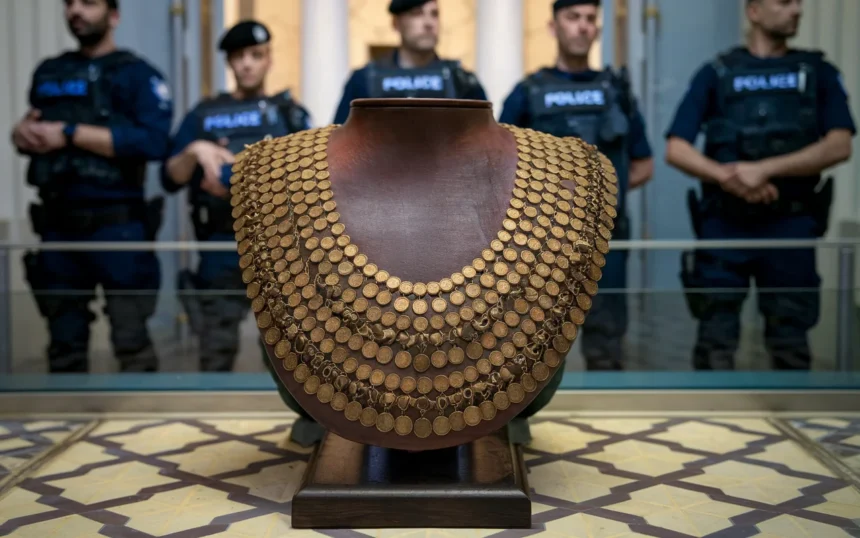Introduction
The world of cultural artifacts is often filled with intrigue, history, and sometimes controversy. Recently, the Women Arrreste Dover Necklace By Israelipolice has sparked significant attention. This beautiful piece of jewelry isn’t just a stunning accessory; it carries deep cultural significance that resonates within communities. As we delve into this captivating story, we’ll explore what makes the Dover Necklace so important and the legal complexities surrounding its ownership. Join us as we uncover layers of meaning behind this cherished artifact while addressing pressing questions about authenticity and preservation in today’s world.
Cultural Significance of the Dover Necklace
The Dover Necklace is more than just an accessory. It embodies a rich tapestry of history and tradition, reflecting the artistic heritage of its creators.
Dating back to ancient times, this ornate piece has been found in various archaeological sites around Israel. Each design element tells a story, offering insight into the culture and beliefs of those who wore it.
For many communities, such artifacts symbolize identity and continuity. They connect present generations with their ancestors, fostering a sense of belonging.
In contemporary society, wearing or displaying cultural symbols like the Dover Necklace can serve as a statement against cultural erasure. It highlights the importance of recognizing and valuing diverse histories within our global community.
Such significance goes beyond aesthetics; it intertwines personal stories with collective memory. The necklace stands as a testament to resilience amid changing tides throughout history.
Questions of Authenticity

Questions around the authenticity of the Dover Necklace have sparked considerable debate. This ancient piece, believed to hold significant cultural value, has seen its fair share of scrutiny.
Many experts are examining its origins and craftsmanship. Authentic artifacts often carry distinctive markings or styles that can help determine their age and provenance.
The challenge lies in distinguishing genuine items from replicas or forgeries. As interest grows, so does the risk of counterfeit pieces entering circulation.
Collectors and historians alike urge caution when assessing such artifacts. Provenance documentation is vital for establishing a necklace’s legitimacy.
Meanwhile, ongoing investigations by authorities aim to clarify these concerns. They work diligently to protect cultural heritage while ensuring that authentic treasures remain preserved for future generations.
Legal Challenges in Cultural Artifact Cases

Legal battles surrounding cultural artifacts often unfold in complex legal landscapes. Ownership claims can involve various stakeholders, including nations, museums, and private collectors.
Jurisdictions may differ significantly when it comes to repatriating items. Some countries have robust laws protecting cultural heritage, while others prioritize commercial interests. This disparity complicates the legal pathways for returning significant pieces like the Dover Necklace.
Additionally, proving authenticity plays a crucial role in these cases. Disputes arise over whether an item is genuine or merely a replica. For instance, documentation might be scarce or disputed.
These challenges highlight the need for transparent policies that respect cultural significance and historical context. Stakeholders must navigate not only legal frameworks but also ethical considerations regarding ownership and stewardship of culturally important objects.
Importance of Cultural Preservation
Cultural preservation is vital in a world that constantly evolves. These practices ensure that traditions, languages, and artifacts are not lost to time or globalization.
Every culture holds stories, values, and identities. When these elements fade, communities risk losing their uniqueness. The Dover Necklace symbolizes heritage; its history connects people to their past.
Preserving culture fosters understanding and respect among diverse communities. It encourages dialogue about our shared human experience while honoring individual narratives.
Additionally, cultural artifacts can play a role in education. They provide tangible links to history for future generations, enhancing awareness of different backgrounds.
Support for cultural preservation also stimulates local economies through tourism and crafts. This creates jobs while maintaining the integrity of community customs.
In essence, safeguarding cultural treasures enriches society as a whole by promoting unity amid diversity.
Impact on Cultural Communities

The recent arrest of a woman in connection with the Dover necklace incident has sparked significant discussion within cultural communities. Artifacts like the Dover necklace hold deep historical value and are often intertwined with identity.
When such items are removed or contested, it can lead to feelings of loss among community members. They see these artifacts not just as objects but as embodiments of their heritage and stories.
Moreover, this situation raises awareness about the importance of protecting cultural property. Communities rally together in advocacy efforts, emphasizing that preserving their history is crucial for future generations.
Conversations around authenticity also emerge within these groups. The debate over ownership and rightful custody fosters deeper engagement and understanding regarding cultural treasures.
When cultures feel threatened by external actions, they unite to defend what matters most to them—ensuring richness continues through shared knowledge and respect for heritage.
Conclusion
The recent incident surrounding the women arrreste dover necklace by israelipolice has stirred up significant conversation. It highlights a delicate balance between law enforcement and cultural heritage.
As discussions unfold, it’s clear that artifacts like the Dover necklace are more than just objects; they carry stories and memories of cultures long past.
Efforts toward preservation must be prioritized, alongside ongoing dialogues about authenticity and ownership.
Cultural communities deserve a voice in these matters, as their identity is often intertwined with such items. The legal landscape remains complex, yet it’s essential to navigate this carefully to protect what truly matters.
Awareness plays a crucial role in shaping future actions regarding cultural artifacts. This situation serves as a reminder of our responsibility towards history and those who contribute to it every day.
FAQs
The recent incident involving the women arrested over the Dover necklace by Israeli police has sparked widespread interest and concern. As discussions continue, many are eager to learn more about this intricate matter.
Q: What is a Dover necklace?
A: The Dover necklace is an ancient piece of jewelry that carries significant cultural value in Israel. It often symbolizes heritage and identity among various communities.
Q: Why was there an arrest related to the Dover necklace?
A: Israeli police apprehended individuals believed to be involved in illegal activities surrounding this culturally important artifact, raising questions about legality and ethics in cultural property cases.
Q: Is the Dover necklace authentic?
A: Questions of authenticity have surfaced due to its historical importance. Experts analyze such artifacts meticulously before declaring them genuine or replicas.
Q: How does cultural preservation play a role?
A: Cultural preservation ensures that items like the Dover necklace remain accessible for future generations. This incident highlights ongoing efforts needed to protect our shared history.
Q: What impact does this situation have on local communities?
A: Communities connected to such artifacts may feel undermined when their culture is threatened by illegal trade or misrepresentation, emphasizing the need for awareness and respect towards cultural heritage.
These questions reflect just a fraction of what people want to understand regarding this case. The debate continues as society navigates through issues of culture, law, and community values tied deeply into identities worldwide.








